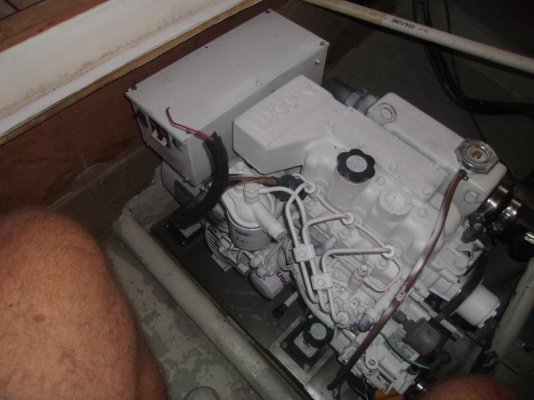healhustler
Guru
- Joined
- Oct 2, 2009
- Messages
- 5,198
- Location
- USA
- Vessel Name
- Bucky
- Vessel Make
- Krogen Manatee 36 North Sea
I've yanked my gen-set from its hell-hole beneath the galley and carved-out a new hatch for it in the aft-deck (veranda) just ahead of the lazzerette hatch. I recon'd the gen-set and gently placed it into the hatch, check all the clearances, leveled the unit, and now I'm ready to make the mounts to rest the entire unit (including the drain pan) between the stringers.
The Northern Lights 4.5 gen-set rests on four new motor mounts on the SS drain pan. The idea is to double insulate the generator vibration by also making the stringer mounts rest on rubber. The pan is 17" wide and there is 19" between the stringers. The hull shape will require me to space it 1/2" aft and 2 1/2" in the front to make the unit level.
Am I going to far trying to insulate the unit further by using more rubber mounts? The unit is 380 lbs. or so. The original mounting was a simple plywood over stringers design, with the drain pan flat dab on the plywood with a few SS retainer clips over the pan.
Thanks in advance for the feedback.
The Northern Lights 4.5 gen-set rests on four new motor mounts on the SS drain pan. The idea is to double insulate the generator vibration by also making the stringer mounts rest on rubber. The pan is 17" wide and there is 19" between the stringers. The hull shape will require me to space it 1/2" aft and 2 1/2" in the front to make the unit level.
Am I going to far trying to insulate the unit further by using more rubber mounts? The unit is 380 lbs. or so. The original mounting was a simple plywood over stringers design, with the drain pan flat dab on the plywood with a few SS retainer clips over the pan.
Thanks in advance for the feedback.


 NL and Westerbeke have on site tech guys and engineers (like Spy) that get paid to come up with the best elastomers. Pay the extra dollars and order from them.
NL and Westerbeke have on site tech guys and engineers (like Spy) that get paid to come up with the best elastomers. Pay the extra dollars and order from them.